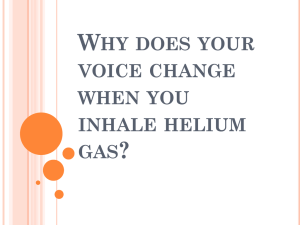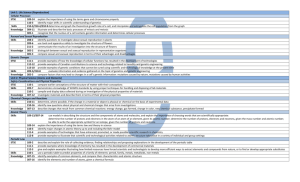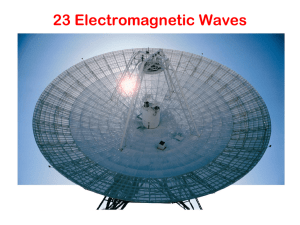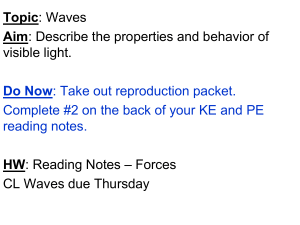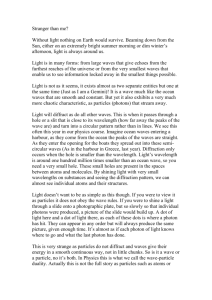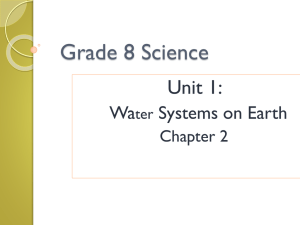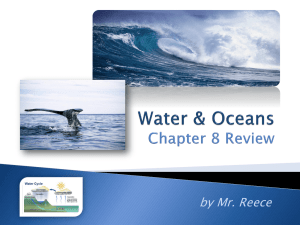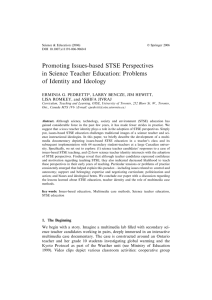8 Unit 1: Earth and Space Systems (Water Systems on Earth) Waves
advertisement
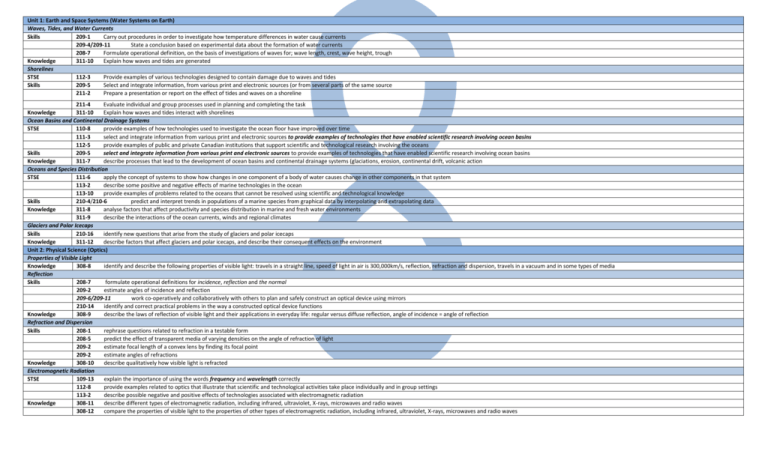
Unit 1: Earth and Space Systems (Water Systems on Earth) Waves, Tides, and Water Currents Skills 209-1 Carry out procedures in order to investigate how temperature differences in water cause currents 209-4/209-11 State a conclusion based on experimental data about the formation of water currents 208-7 Formulate operational definition, on the basis of investigations of waves for; wave length, crest, wave height, trough Knowledge 311-10 Explain how waves and tides are generated Shorelines STSE 112-3 Provide examples of various technologies designed to contain damage due to waves and tides Skills 209-5 Select and integrate information, from various print and electronic sources (or from several parts of the same source 211-2 Prepare a presentation or report on the effect of tides and waves on a shoreline 211-4 Evaluate individual and group processes used in planning and completing the task Knowledge 311-10 Explain how waves and tides interact with shorelines Ocean Basins and Continental Drainage Systems STSE 110-8 provide examples of how technologies used to investigate the ocean floor have improved over time 111-3 select and integrate information from various print and electronic sources to provide examples of technologies that have enabled scientific research involving ocean basins 112-5 provide examples of public and private Canadian institutions that support scientific and technological research involving the oceans Skills 209-5 select and integrate information from various print and electronic sources to provide examples of technologies that have enabled scientific research involving ocean basins Knowledge 311-7 describe processes that lead to the development of ocean basins and continental drainage systems (glaciations, erosion, continental drift, volcanic action Oceans and Species Distribution STSE 111-6 apply the concept of systems to show how changes in one component of a body of water causes change in other components in that system 113-2 describe some positive and negative effects of marine technologies in the ocean 113-10 provide examples of problems related to the oceans that cannot be resolved using scientific and technological knowledge Skills 210-4/210-6 predict and interpret trends in populations of a marine species from graphical data by interpolating and extrapolating data Knowledge 311-8 analyse factors that affect productivity and species distribution in marine and fresh water environments 311-9 describe the interactions of the ocean currents, winds and regional climates Glaciers and Polar Icecaps Skills 210-16 identify new questions that arise from the study of glaciers and polar icecaps Knowledge 311-12 describe factors that affect glaciers and polar icecaps, and describe their consequent effects on the environment Unit 2: Physical Science (Optics) Properties of Visible Light Knowledge 308-8 identify and describe the following properties of visible light: travels in a straight line, speed of light in air is 300,000km/s, reflection, refraction and dispersion, travels in a vacuum and in some types of media Reflection Skills 208-7 formulate operational definitions for incidence, reflection and the normal 209-2 estimate angles of incidence and reflection 209-6/209-11 work co-operatively and collaboratively with others to plan and safely construct an optical device using mirrors 210-14 identify and correct practical problems in the way a constructed optical device functions Knowledge 308-9 describe the laws of reflection of visible light and their applications in everyday life: regular versus diffuse reflection, angle of incidence = angle of reflection Refraction and Dispersion Skills 208-1 rephrase questions related to refraction in a testable form 208-5 predict the effect of transparent media of varying densities on the angle of refraction of light 209-2 estimate focal length of a convex lens by finding its focal point 209-2 estimate angles of refractions Knowledge 308-10 describe qualitatively how visible light is refracted Electromagnetic Radiation STSE 109-13 explain the importance of using the words frequency and wavelength correctly 112-8 provide examples related to optics that illustrate that scientific and technological activities take place individually and in group settings 113-2 describe possible negative and positive effects of technologies associated with electromagnetic radiation Knowledge 308-11 describe different types of electromagnetic radiation, including infrared, ultraviolet, X-rays, microwaves and radio waves 308-12 compare the properties of visible light to the properties of other types of electromagnetic radiation, including infrared, ultraviolet, X-rays, microwaves and radio waves Unit 3 Physical Science (Fluids) Floating and Sinking - Density Skills 208-2 identify questions to investigate arising from practical problems involving floating, sinking, and density 208-6/211-3 work cooperatively with team members to design an experiment and identify major variables in order to investigate floating , sinking and density 210-7/307-11 analyse quantitatively the density of various substances and suggest explanations for discrepancies in data, such as the measurement of the volume of irregular objects by water displacement Knowledge 307-8 describe the relationship among the mass, volume ad density of solids, liquids and gases using the particle model of matter 307-9 explain the effects of changes in temperature on the density of solids, liquids and gases and relate the results to the particle model of matter 307-10 describe situations in life where the density of substances naturally changes or is intentionally changed Forces in Fluids STSE 111-1 provide examples of technologies that have been developed because of our understanding of density and buoyancy 111-5 describe the science underlying hydraulic technologies Skills 210-13 test and compare a student-constructed dynamometer with a commercial dynamometer Knowledge 210-14 309-1 309-2 309-3 309-4 calibrate a student-constructed dynamometer with known masses describe qualitatively the difference between mass and weight describe the movement of objects in terms of balanced and unbalanced forces explain quantitatively the relationship between force, area, and pressure explain qualitatively the relationship among pressure, volume, and temperature when liquid and gaseous fluids are compressed or heated Viscosity of Liquids STSE 109-10/112-7/210-12 Skills Knowledge 208-6 209-3 209-7 307-6 307-7 identify and relate personal activities and potential applications to fluid dynamics design an experiment to test the viscosity of various common fluids and identify the major variables use a temperature-measuring technology effectively and accurately for collecting data in temperature-viscosity investigations demonstrate a knowledge of WHMIS standards by demonstrating the correct methods of disposal of various oils, for example compare the viscosity of various liquids describe factors that can modify the viscosity of a liquid Unit 4 Life Science (Cells, Tissues, Organs and Systems) Cells STSE Skills 109-13 explain that it is important to use proper terms when comparing plant and animal cells 209-3 use a light microscope or microviewer correctly to produce a clear image of cells 211-3 work co-operatively with team members to develop and construct models of cells Knowledge 304-4 illustrate and explain that the cell is a living system that exhibits the following characteristics of life 304-5 distinguish between plant and animal cells 304-6 explain that growth and reproduction depend on cell division Interdependence Among Cells, Tissues, Organs and Systems STSE 110-2 compare the early idea that living organisms were made of air, fire and water with the modern cell theory Skills 211-4 evaluate individual and group processes used in researching the roles of the main organ systems Knowledge 304-7 explain structural and functional relationships between and among cells, tissues, organs and systems in the human body 304-8 relate the needs and functions of various cells and organs to the needs and functions of the human organism as a whole Healthy / Unhealthy Systems STSE 110-5 illustrate examples of conflicting evidence related to how we should maintain and/or treat body systems 111-5 describe the science underlying various technologies used to assist or replace unhealthy organs and systems Knowledge 304-9 describe the basic factors that affect the functions and efficiency of the human respiratory, circulatory, digestive, excretory and nervous systems Interdependence of Body Systems STSE Skills 112-10 provide examples of careers that are associated with the health of body systems 113-8 make informed decisions about applications of science and technology that are associated with human body systems, taking into account personal and social advantages and disadvantages 208-1 rephrase questions into testable form about the factors that affect physical fitness and health 208-6/209-1 design and carry out an experiment to compare and contrast heart rate and breathing rate in an individual during various levels of activity, and identify and control the major variables 210-7 suggest explanations for variations in the heart rate and the breathing rate of an individual during various levels of activity when the experiment is repeated Knowledge 304-10 describe three examples of the interdependence of various systems of the human body
